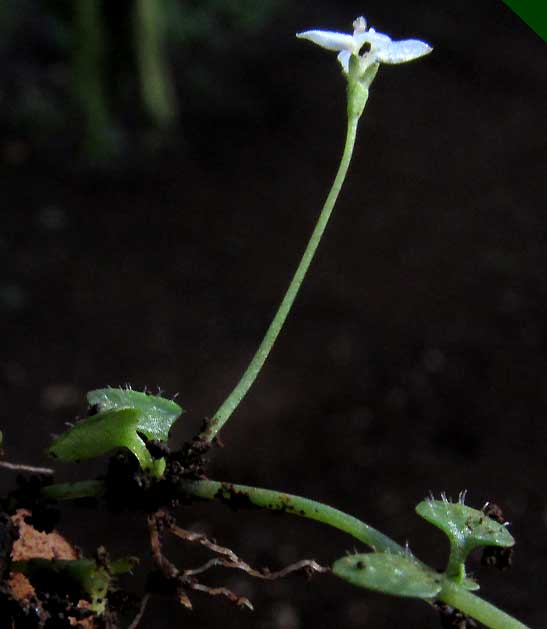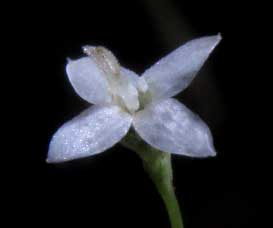Excerpts from Jim Conrad's
Naturalist Newsletter
from the January 24, 2016 Newsletter issued from Hacienda Chichen Resort beside Chichén Itzá Ruins; limestone bedrock; elevation ~39m (~128ft), N20.675°, W88.569°; central Yucatán state, MÉXICO
HEDYOTIS
In the organic garden's Papaya section the gardeners try hard to keep out the weeds, the ground below the Papaya trees for the most part being naked dirt. Therefore, when a small patch of herbage turned up, it called attention to itself, and once noticed, it looked like something new for me. Below, you can see the lilliputian plant:

Normally I'd not even think of trying to identify such a minuscule plant but then I noticed the flower at about 4 o'clock from the tip of my lower finger in the picture, and with a flower there's always a good chance for an ID. Pushing my camera's macro capabilities to its limit and then later doing the same with PhotoShop, I got what's shown below:

Even in the first picture we saw that the corolla was four-parted, and now we see another field mark just as important: The flower has an inferior ovary. That means that the white corolla, green sepals and sexual parts arise above the ovary, not below it. Most ovaries are superior. On this flower the inferior ovary is apparent because of how the flower part below the green, finger-like sepals is swollen, before attaching to the slender flower stem, or pedicel, farther down.
 The picture also shows that the plant bears two leaves per stem node -- they're "opposite" -- and that the ground-hugging stem roots at its leaf-producing nodes. The bristly, while hairs scattered atop the leaves' surfaces are worth noting, too. A close-up of the four-parted flower is shown at the right.
The picture also shows that the plant bears two leaves per stem node -- they're "opposite" -- and that the ground-hugging stem roots at its leaf-producing nodes. The bristly, while hairs scattered atop the leaves' surfaces are worth noting, too. A close-up of the four-parted flower is shown at the right.
In that picture the white, hand-like item emerging from the blossom's throat is the style atop which there's a thick, deeply divided stigma, and it looks like there are four stamens, each affixed where the corolla lobs connect at their bases.
When you have an herb with opposite leaves, inferior ovary, and flowers with parts in fours, the best bet is that the plant is a member of the big Madder or Coffee Family, the Rubiaceae. By doing image searches on the genera of that family known to occur in the Yucatan, and which I didn't know, quickly pictures of our little plant were found.
Our plant is HEDYOTISIS CALLITRICHOIDES*, distributed from Mexico south to Panama and in the Caribbean Antilles. It's so small and generally unnoticed that I can't find a name for it, not in English, Spanish or Maya, so we'll just call it Hedyotis.
In fact, on the Internet there's very little information about it -- just a few listings where it's been identified here and there, without comments. One observation I can make is that at the Hacienda I find it only where plants are watered each day.
Anonymity often is the fate of plants with no commercial value, which aren't agricultural or ecological threats, and are not used medicinally. Still, ecologically we can see our little Hedyotis is a "pioneer species" trying to stabilize naked soil.